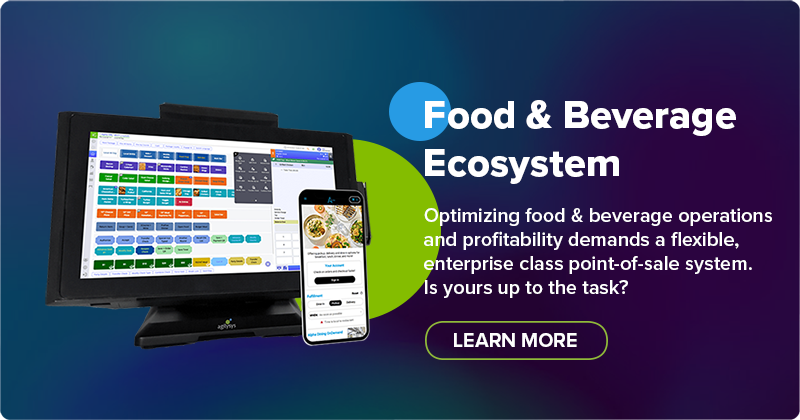
- Solutions
- Food & Beverage Ecosystem
Food & Beverage Ecosystem
Optimizing food & beverage operations and profitability demands a flexible, enterprise-class point-of-sale system. Is yours up to the task?
Go- Hospitality & Leisure Ecosystem
Hospitality & Leisure Ecosystem
From an individual location to an enterprise chain, get the most modern, mobile solution for managing your hospitality business
Go
- Inventory & Procurement Ecosystem
Inventory & Procurement Ecosystem
Designed to optimize foodservice and retail inventory and procurement operations for hotels, resorts, universities, restaurants and others.
Go
- Professional Services
Professional Services
Hospitality businesses are global, 24/7 operations with complex technology demands. You don’t have to go it alone.
Go
- Solution Studios
- Hotels
Hotels
Whether you operate a single boutique location or a large hotel chain, there’s an Agilysys hotel solution for you.
Go- Resorts
Resorts
Whether you operate a single boutique location or a large complex resort, your property is a unique operation that requires robust solutions supported by an experienced technology partner
Go
- Casinos
Casinos
You’re more than a gaming operation. You’re a full-service casino resort property and success isn’t about playing the odds, it’s about making the most of every revenue opportunity.
Go
- Tribal Gaming
Tribal Gaming
A leader in casino hospitality management solutions who respects the sovereignty of your nation.
Go
- Cruise Lines
Cruise Lines
Smooth seas ahead: technology solutions from Agilysys, a leader in cruise management systems.
Go
- Higher Education
- Corporate Dining
Corporate Dining
Identify emerging dining trends while aligning coverage with demand and capturing more revenue.
Go
- Healthcare
Healthcare
Delight patients & visitors, retain staff and grow margins with a suite of hospitality solutions for healthcare environments.
Go
- Life Plan Communities
- Foodservice Management
Foodservice Management
End-to-end foodservice management software solutions for optimum productivity and profitability.
Go
- Stadiums
- Restaurants
- Airports
Airports
Optimizing dozens of food & beverage outlets throughout your facility demands world-class POS performance combined with real-time operating insights.
Go
- Resorts
- Resources
- Articles
Articles
Access our library and read about the latest in emerging technology and other hospitality trends. Find tips and insights on accelerating business growth and improving guest satisfaction.
Go- Customer Stories
Customer Stories
Learn why so many businesses, small and large, partner with Agilysys for their hospitality technology needs.
Go
- Customer Videos
Customer Videos
Watch and learn what Agilysys customers have to say about their experiences with our solutions.
Go
- Product Resources
Product Resources
An in-depth collection of product information and datasheets. Read about the latest in hospitality technology features designed to solve the challenges faced by hospitality professionals around the globe.
Go
- Product Showcase
Product Showcase
Hear from industry professionals about the latest advancements, including tips and tricks, in hospitality and emerging technologies. Check out the library of demo videos and webinar recordings.
Go
- Webinars
Webinars
Watch and learn about the latest in successful technology trends and hear from hospitality professionals in this selection of interactive videos.
Go
- Industry Reports
Industry Reports
Important research and studies from across the hospitality industry. Find out what thought leaders are saying.
Go
- Customer Stories
- Company
- Leadership
- Solution Partners
Solution Partners
Agilysys has a broad collection of partners and APIs to help you assemble the perfect solution for you.
Go
- Our Customers
Our Customers
Discover how Agilysys customers like you are using our solutions to improve their business and guest experience.
Go
- Investor Relations
- News
- Events
Events
With the Agilysys commitment to 100% Hospitality solutions, we take industry events and conferences seriously. Please see where you can find Agilysys to learn more.
Go
- Career
- FAQS
FAQS
Go
- Solution Partners
- Support
- Contact Support
- Microsoft Patch Testing
Microsoft Patch Testing
See what Microsoft products and versions are currently support by Agilysys.
Go
- Payment Center
- RMA Requests
- Supply Order
Supply Order
Go
- Hospitality IQ
Hospitality IQ
Go
- Knowledge Center
Knowledge Center
Go
- Microsoft Patch Testing
- Blogs
- MyAgilysys
-
 Get a Demo
Get a Demo 877 369 6208
877 369 6208
×Home
☰- Explore
WHAT'S THE BUZZ IN HOSPITALITY?
How to Write a Restaurant Business Plan
Creating a restaurant business plan is a critical step in launching a successful dining establishment. This document serves as a roadmap for your business, outlining your concept, target market, financial projections, and strategies for growth. Whether you're opening a casual café or a high-end restaurant, a well-crafted business plan will help you secure funding, attract partners, and navigate the challenges of the foodservice industry. Here’s a step-by-step guide on how to write a comprehensive restaurant business plan.
1. Executive Summary
The executive summary is the first section of your business plan but should be written last. It provides a concise overview of your entire plan, highlighting the most critical points. This section should include:
- Business Concept: A brief description of your restaurant, including its name, location, and the type of cuisine you'll offer.
- Mission Statement: Define your restaurant’s purpose and core values.
- Goals and Objectives: Outline your short-term and long-term goals.
- Keys to Success: Identify the factors that will contribute to your restaurant's success.
Though this section is brief, it is crucial as it sets the tone for the rest of the document and is often the first thing investors will read.

2. Company Description
In this section, provide a detailed description of your restaurant. This should include:
- Legal Structure: Describe the legal structure of your business (e.g., sole proprietorship, partnership, corporation).
- Ownership: Introduce the owners of the restaurant and their roles.
- Concept and Theme: Explain the overall concept, theme, and atmosphere you plan to create. This includes your restaurant’s design, décor, and any unique selling points (USPs).
- Location: Detail the location of your restaurant, including why you chose this area and how it fits with your target market.
This section is where you establish your restaurant's identity and differentiate it from competitors.
3. Market Analysis
A thorough market analysis is essential for understanding the competitive landscape and identifying your target customers. This section should cover:
- Industry Overview: Provide an analysis of the restaurant industry, focusing on trends, growth rates, and market size.
- Target Market: Define your target audience, including demographic information such as age, income level, lifestyle, and dining preferences.
- Competitive Analysis: Identify your direct and indirect competitors. Analyze their strengths and weaknesses, and explain how your restaurant will stand out.
- Market Needs: Discuss the unmet needs in the market that your restaurant will address.
A well-researched market analysis demonstrates that you understand your customers and the competitive environment.
4. Menu and Services
The menu is the heart of any restaurant. In this section, provide a sample menu that showcases your offerings. Include:
- Menu Items: List the dishes, beverages, and any special items you plan to serve. Consider including pricing to demonstrate the perceived value.
- Menu Design: Describe the visual and conceptual design of the menu, emphasizing how it complements your restaurant’s theme.
- Special Services: Outline any additional services you’ll offer, such as catering, delivery, or private events.
Your menu should reflect the overall concept of your restaurant and appeal to your target market.

5. Marketing and Sales Strategies
Your marketing and sales strategies will determine how you attract and retain customers. This section should include:
- Branding: Describe your branding strategy, including your logo, color scheme, and brand voice.
- Promotion: Detail the promotional tactics you’ll use to generate buzz, such as social media campaigns, influencer partnerships, or local events.
- Sales Strategy: Explain how you plan to increase sales, such as offering loyalty programs, special promotions, or upselling techniques.
- Pricing Strategy: Discuss your pricing strategy and how it aligns with your market positioning.
An effective marketing plan will help you build a strong brand and drive traffic to your restaurant.
6. Operations Plan
The operations plan outlines the day-to-day management of your restaurant. This section should cover:
- Staffing: Detail your staffing needs, including the number of employees, their roles, and any training programs you’ll implement.
- Suppliers: Identify your key suppliers for ingredients, equipment, and other essentials.
- Technology: Discuss any technology you’ll use, such as point-of-sale (POS) systems, online reservation platforms, or kitchen management software.
- Health and Safety: Outline the health and safety protocols you’ll follow to comply with local regulations.
A solid operations plan ensures that your restaurant runs smoothly and efficiently.
7. Management Team
Investors want to know that your restaurant is in capable hands. In this section, introduce your management team:
- Owner/Founder: Provide a brief biography, including your experience and expertise in the restaurant industry.
- Key Personnel: Introduce key members of your management team, such as the head chef, general manager, and marketing director. Include their qualifications and roles within the business.
- Advisors: Mention any advisors or consultants who will contribute to your restaurant’s success.
Highlighting a strong management team can build confidence in your ability to execute the business plan.

8. Financial Plan
The financial plan is one of the most critical sections of your business plan, especially for potential investors. It should include:
- Startup Costs: Outline the initial costs of launching your restaurant, including rent, equipment, licenses, and marketing.
- Revenue Projections: Provide detailed revenue projections for the first few years, broken down by month or quarter.
- Profit and Loss Statement: Include a projected profit and loss statement, showing expected revenues, costs, and profits.
- Break-Even Analysis: Calculate the point at which your restaurant will become profitable.
- Funding Requirements: If you’re seeking investment, specify how much capital you need and how you plan to use it.
Accurate financial projections demonstrate the viability of your business and its potential for growth.
9. Appendix
The appendix is where you can include any additional information that supports your business plan. This may include:
- Resumes of Key Personnel
- Sample Menus
- Market Research Data
- Legal Documents
- Floor Plans
The appendix provides supplementary material that gives investors a deeper understanding of your business.
Writing a restaurant business plan requires careful planning and research. By following these steps, you’ll create a comprehensive and compelling plan that will guide your restaurant’s growth and attract potential investors. Remember, a well-thought-out business plan is not just a tool for securing funding; it’s a roadmap for your success in the competitive restaurant industry.

2026 Hospitality Industry Conferences You Shouldn't Miss
Read More
The 2025 Global Hospitality Study
Download Study
The Guest Economy: Top 5 Hospitality Technology Predictions for 2026
Learn MoreCategories
- Contact Support
- Leadership
- Articles
- Hotels
- Food & Beverage Ecosystem




